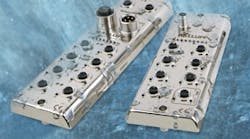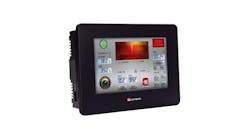Many packaging customers use distributed I/O, but packaging OEM design is moving closer to the food-processing-equipment design area. The FDA Food Safety Modernization Act (FSMA) is pushing these requirements on manufacturers. “In response, the packaging OEMs are starting to follow some of the same requirements,” says Shishir Rege, networking marketing manager at Balluff. “As a result, washdown ratings and requirements are affecting machine design.”
Many benefits found in Balluff’s new machine-mount distributed I/O network blocks were not available to the machine builder or food and beverage manufacturers in a washdown environment, says Rege. “They had to rely on centralized, cabinet-mounted technology, which takes a long time to develop and install,” he explains.
Rege believes machine-mount technology is an easier and more cost-effective way to connect field I/O and build modular systems. “This machine-mount technology is popular in automotive applications,” he says. “Automotive started the trend; general packaging and food and beverage is a bit behind often using cabinet mountI/O. The washdown environment may have driven that trend, keeping common NEMA 4X enclosures all along the line, for example. Now, having these IP69K blocks with ECOLAB certification helps to get the I/O out of the cabinets and onto the machines, improving modularity and flexibility to connect a variety of smart sensors and devices.”
For More Information Call 800/543-8390, email [email protected] or browse to www.balluff.us.
Balluff’s machine-mount network blocks offer IP69K protection. “This allows customers in the food, dairy and beverage industries to pressure-wash this distributed modular I/O block,” explains Rege. “It’s no longer necessary to install all the hardware in a pressure-wash-rated enclosure or locate the distributed modular I/O outside the pressure-wash zone.”
ALSO READ: How distributed I/O can work on packaging lines
The network block also reduces the possibility of human error because this new design provides connections, not terminations. “The I/O and communication are connected directly to the block using M12 connectors commonly found on sensor cables,” says Rege. “Power connections use 7/8-in connectors. Additionally, cable routing in a washdown environment can be expensive and labor-intensive. There is no need to route all the wires back to the control cabinet and then strip, label and terminate them.” Balluff’s network blocks daisy-chain power in one cable connection and network signals in a second cable connection. The network blocks also come with a built-in Web server, which can be used to configure each device, troubleshoot devices and read diagnostic and status information.
Distributed architecture
The machine-mount distributed I/O network blocks are available in three network block configurations and two communication protocol options EtherNet/IP and Profinet. Two of the network block configurations are I/O only with 16 inputs, or 16 configurable inputs or outputs. The third configuration provides eight IO-Link ports (IO-Link master).
Alongside the IO-Link master, Balluff is also introducing IO-Link I/O hubs with the IP69K protection rating and ECOLAB certification. Each I/O hub can collect up to 16 inputs or control 16 outputs. Together, the IO-Link master and the I/O hubs can control up to 240 I/O points on a single network node, designed to reduce significant costs for I/O by reducing the number of network nodes and cables.
Both masters and hubs are packed with diagnostics onboard for short circuit, overcurrent and communications, plus, with their protection rating and ability to withstand harsh chemicals, they reduce sensor cable runs. Combined with reduced cable runs and the ability to connectorize instead of terminating individual wires, Balluff’s IO-Link-based architecture is designed to reduce the total time to market for machine builders while providing enhanced ease of use for end users.
The network blocks with IO-Link master enable connecting IO-Link smart sensors or I/O hubs, such as valve manifolds, on the machine. In addition to sensor information, IO-Link provides automatic configuration, parameterization and diagnostics for the I/O blocks and a variety of smart sensors such as temperature, color, RFID and photoelectrics.
The network blocks include simple network management protocol (SNMP), providing IIoT connectivity to enterprise-level network management systems. Network management systems can collect information from the IO-Link devices, enabling machine status monitoring and asset tracking functionality with little impact on the control network.
To speed integration of the network blocks, add-on instructions and function blocks are available for free from Balluff. “This makes it easier to configure and communicate with the block or related smart devices on a variety of control platforms,” says Rege.







